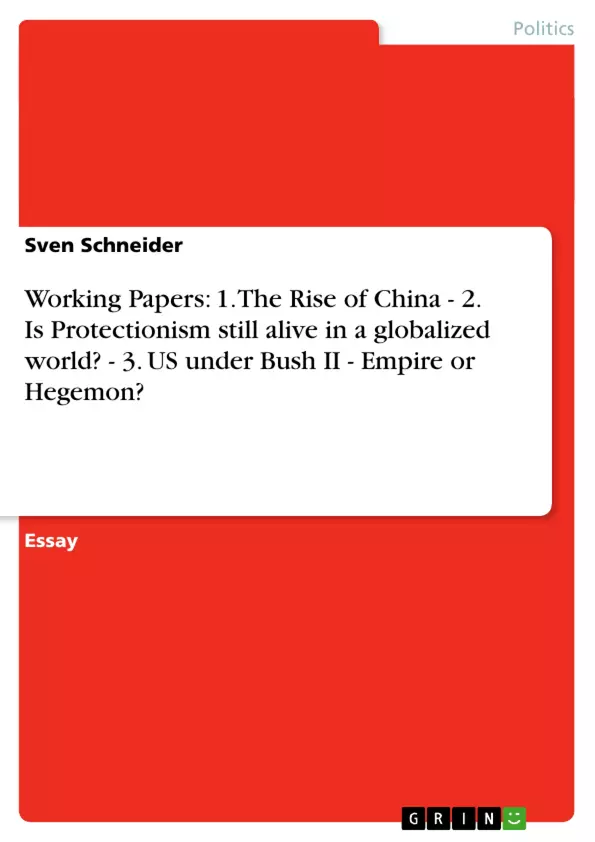The following three essays are working papers on different issues, like "The Rise of China", protectionism and the understanding of the US being an empire or a hegemon. These have been written during a research visit at the Research School of Pacific and Asian Studies, Australian National University.
While the first essay on "The Rise of China" is concerned with the relation of Australia and the US, which seems to be influenced by the rising star of China, the second essay also talks about a very topical issue of protectionism in a globalized or globalizing world. The ongoing crisis of finance since the end of 2008 and the following recession is challenging free trade and liberalism today. In regard to "The Rise of China" the issue became more and more important since Chinese companies seem to buy out the Australian economy in 2009.
Finally, the last essay is focused on the question of how the United States should be understood in regard to its foreign policy. Referring to the concepts of empire and hegemony, the author introduces the two cases of ancient Athens and Sparta. As Athens is seen as the ideal empire and Sparta is supposed to be the ideal hegemon, the essay compares both Greek city-states and their policies with the US foreign policies under Bush II and the neocons.
Inhaltsverzeichnis (Table of Contents)
- 1. Introduction
- 2. The Rise of China: China approaching the US
- 3. Australia between China and the US
- 3.1 Australia and the US: “Most faithful allies”
- 3.2 Australia and China: “Facing the Dragon”
- 4. The Rise of China and Implications for Australia
Zielsetzung und Themenschwerpunkte (Objectives and Key Themes)
This essay analyzes the implications of China's rise for Australia, particularly in relation to the United States. It explores how Australia navigates its relationships with these two major powers, considering both historical context and contemporary challenges.
- The economic and security dimensions of China's rise
- Australia's unique relationship with the United States
- The evolving economic ties between Australia and China
- The strategic balancing act Australia faces between its major partners
- The implications of China's growing influence on Australia's foreign policy
Zusammenfassung der Kapitel (Chapter Summaries)
Chapter 1: Introduction introduces the essay's central question: how China's rise impacts Australia's relationship with the US. It establishes the context of Australia's historical alliances and its growing economic ties with China.
Chapter 2: The Rise of China: China approaching the US examines China's economic and military growth, comparing it to the United States and exploring the implications for regional and global power dynamics.
Chapter 3: Australia between China and the US explores Australia's longstanding security alliance with the US and its developing economic relationships with China. It analyzes the complexities of balancing these two powerful relationships.
Chapter 3.1: Australia and the US: “Most faithful allies” details the historical foundation of the Australia-US alliance, tracing its roots to World War II and subsequent security treaties. It also examines the contemporary aspects of this relationship, including recent military collaborations and the Australia-US Free Trade Agreement (FTA).
Chapter 3.2: Australia and China: “Facing the Dragon” traces the development of Australia's economic relations with China, noting the early establishment of trade ties and the subsequent growth in economic interdependence. It also addresses the evolving security dialogue between the two countries.
Chapter 4: The Rise of China and Implications for Australia examines the strategic challenges facing Australia as it balances its relationships with China and the US. It considers how Australia's foreign policy priorities are shaped by its ties to both countries and the broader regional dynamics.
Schlüsselwörter (Keywords)
Rise of China, Australia-US alliance, Australia-China relations, economic interdependence, security, soft power, neo-mercantilism, protectionism, globalization, national interest, balancing act, ANZUS Treaty, Free Trade Agreement (FTA), Taiwan.
- Arbeit zitieren
- Sven Schneider (Autor:in), 2007, Working Papers: 1. The Rise of China - 2. Is Protectionism still alive in a globalized world? - 3. US under Bush II - Empire or Hegemon?, München, GRIN Verlag, https://www.grin.com/document/123674



